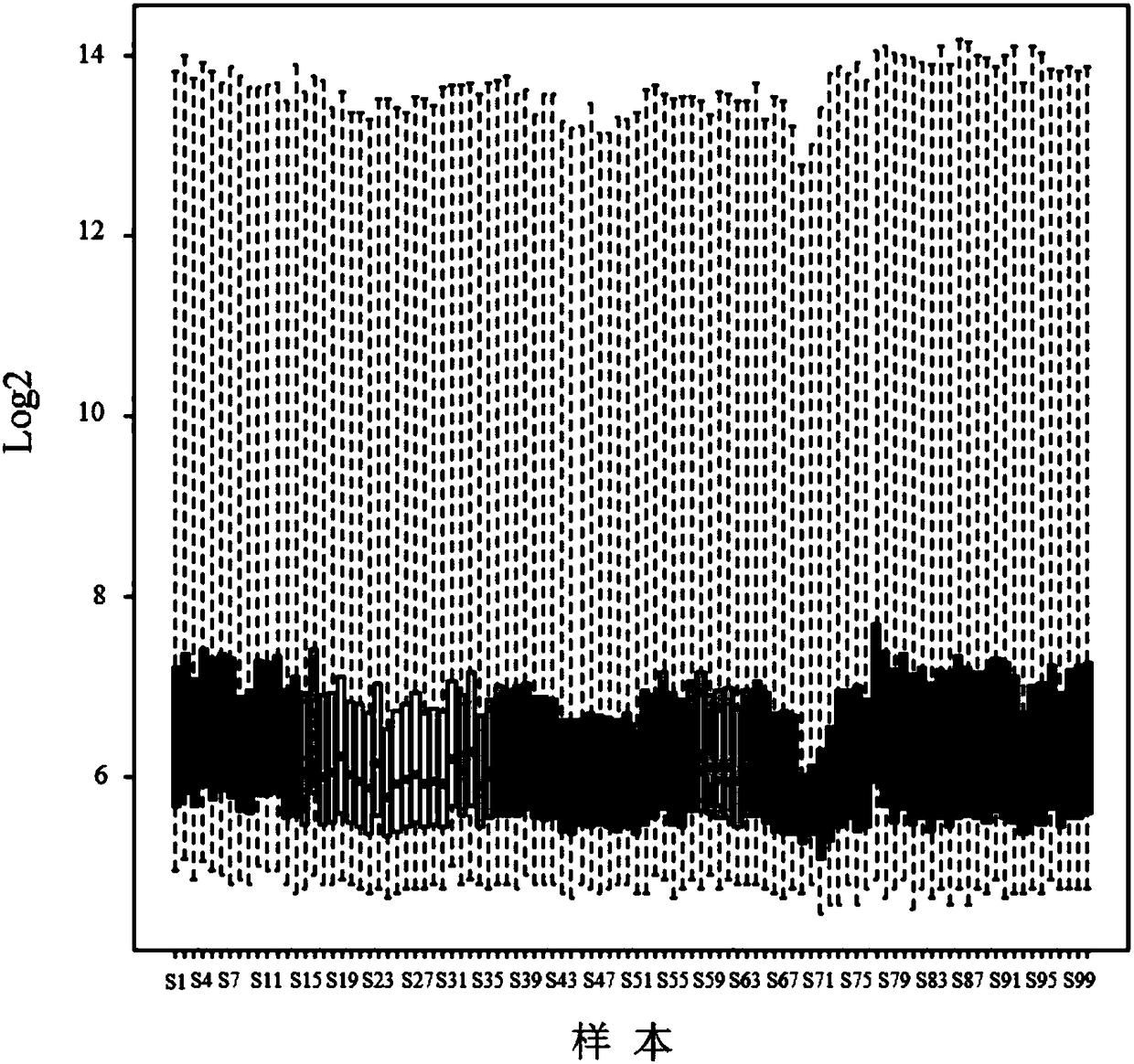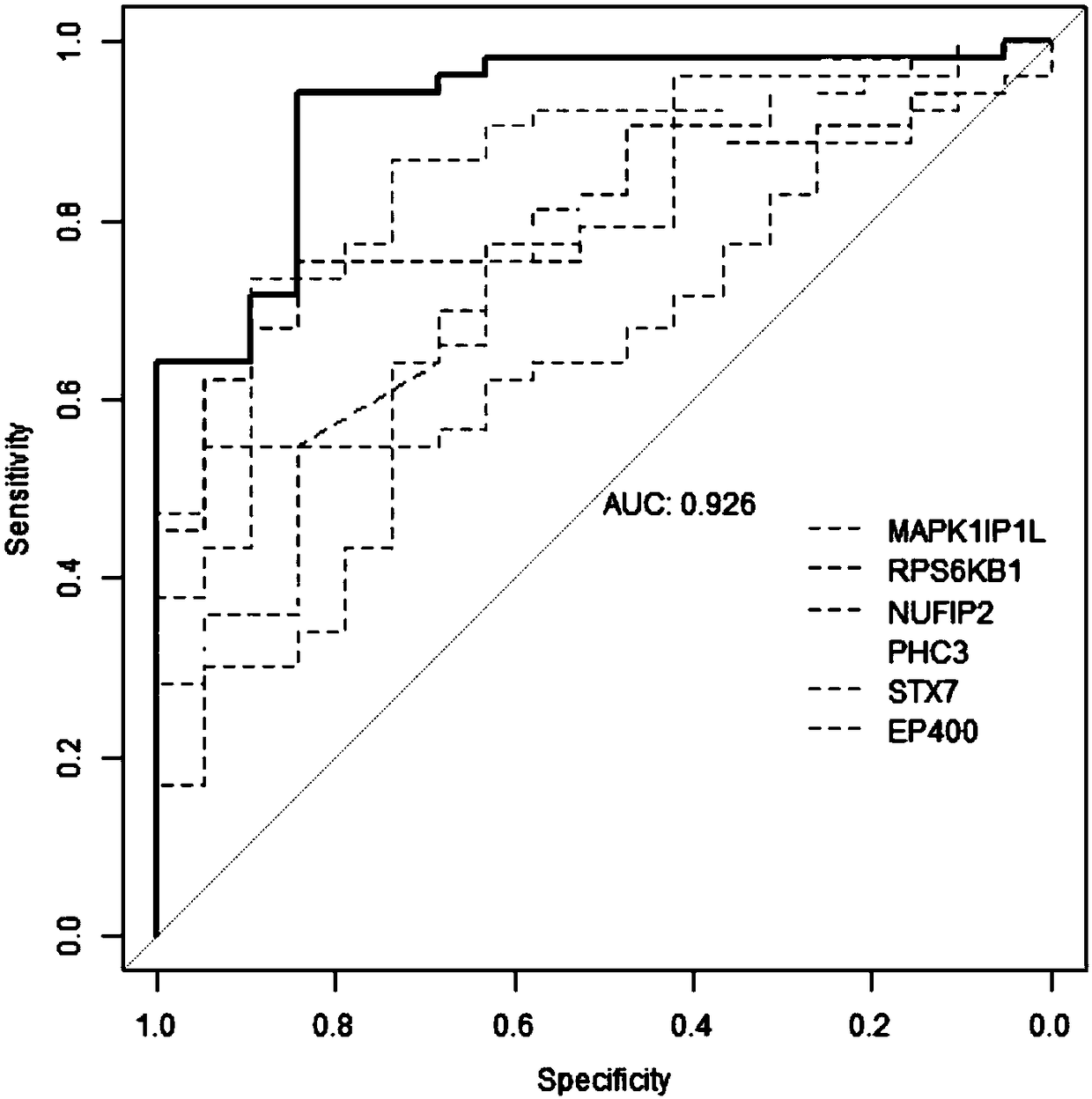Gene marker for detecting liver cancer and application thereof
A gene marker and biomarker technology, applied in the field of gene markers, can solve the problems of lack of specificity and delayed treatment, and achieve the effects of strong specificity, reduced missed detection, and simple detection process
- Summary
- Abstract
- Description
- Claims
- Application Information
AI Technical Summary
Problems solved by technology
Method used
Image
Examples
Embodiment 1
[0040] Example 1 Screening of Liver Cancer Characteristic Gene Markers
[0041] 1. Materials and methods
[0042] (1) Materials
[0043] From November 2012 to July 2013, the inventor entrusted Peking University Shenzhen Hospital to collect a large number of peripheral blood samples from normal people, patients with liver cancer and patients with benign liver diseases (the samples used for research were collected, sampled, subpackaged, Homogeneous storage conditions), through sorting out the sample data, the inventor selected 81 patients' plasma (hepatitis B-liver cancer (including primary liver cancer and intrahepatic cholangiocarcinoma)) and 19 cases randomly collected from the same hospital and the experimental group during the same period. For the plasma of normal people, try to avoid taking plasma samples from people with a family history of liver cancer for mRNA detection.
[0044] The inclusion of hepatocellular carcinoma samples all met the following two criteria: ① P...
Embodiment 2
[0058] Embodiment 2 detects the fluorescent quantitative RT-PCR kit of liver cancer
[0059] 1. Kit composition:
[0060] 1. Detect the specific primers of 6 liver cancer characteristic gene markers (shown in table 1):
[0061] Reagent 1: EP400 gene forward primer: 5'GGATCTTGTCAGTGACGTTGT 3' (SEQ ID NO: 7)
[0062] Reagent 2: EP400 gene reverse primer: 5'GTAGCGATTCCGGCACTGT 3' (SEQ ID NO: 8)
[0063] Reagent 3: MAPK1IP1L gene forward primer: 5'ACCTGAGGCAGCTCTTTTGC 3' (SEQ ID NO: 9)
[0064] Reagent 4: MAPK1IP1L gene reverse primer: 5'GGATGTGTGTGCTCCTTCTAAAGAA3' (SEQ ID NO: 10)
[0065]Reagent 5: NUFIP2 gene forward primer: 5'TTTCTCTCAAAGGACTACGAGAT 3' (SEQ ID NO: 11)
[0066] Reagent 6: NUFIP2 gene reverse primer: 5'AGCAGCCCTCAGGTCAAA 3' (SEQ ID NO: 12)
[0067] Reagent 7: PHC3 gene forward primer: 5'CAGTTTCTACCAGCGGCAGTA 3' (SEQ ID NO: 13)
[0068] Reagent 8: PHC3 gene reverse primer: 5'GGTAGCGGGTGTGAAAATCA 3' (SEQ ID NO: 14)
[0069] Reagent 9: RPS6KB1 gene forward pr...
Embodiment 3
[0087] Example 3 Using the screened liver cancer characteristic gene markers to carry out screening and diagnosis of normal people
[0088] 1. Method steps
[0089] 1. Collection of peripheral blood samples of samples to be tested: Use BD PAXgeneRNA blood collection tubes from QIAGEN to collect peripheral blood samples from patients. Sample source is with embodiment 1.
[0090] 2. Extraction and purification of total RNA in the peripheral blood sample of the sample to be tested: use QIAGEN's PAXgeneBloodRNA Kit to extract and purify the total RNA in the peripheral blood, and use the Agilent BioAnalyzer2100 microelectrophoresis analyzer to identify the integrity and yield of the extracted total RNA fragments;
[0091] 3. Reverse transcription reaction: use Life Techonolgy's High-Capacity cDNA ReverseTranscription kit reverse transcription kit, use total RNA as a template, and use Random Primes as reverse transcription primers to perform reverse transcription reaction to synthe...
PUM
 Login to View More
Login to View More Abstract
Description
Claims
Application Information
 Login to View More
Login to View More - R&D
- Intellectual Property
- Life Sciences
- Materials
- Tech Scout
- Unparalleled Data Quality
- Higher Quality Content
- 60% Fewer Hallucinations
Browse by: Latest US Patents, China's latest patents, Technical Efficacy Thesaurus, Application Domain, Technology Topic, Popular Technical Reports.
© 2025 PatSnap. All rights reserved.Legal|Privacy policy|Modern Slavery Act Transparency Statement|Sitemap|About US| Contact US: help@patsnap.com



